Zimbabwe, Homo Erectus, Boskopoid, Khoi-Khoi, Hottentot,
Gokomere, Bushman | Harare, Masvingo, Great Enclosure,
Mutirikwe Gorge | Hwange, Hwange Nat.Park | Victoria
Falls, Botako Gorg, Zambezi | Botswana, Chobe | Lupane,
Bulawayo, Powangwe cave | Beitbridge |
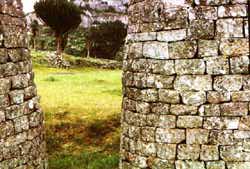 The human history in Zimbabwe extends back through the millennia to the
first rumblings of humanity on earth. Continuing controversy amongst scholars
makes it difficult to determine the latest opinion on who evolved into whom, but
most accept that the earliest human-like creatures were a group op
upright-walking hominids who became established nearly four million years ago in
the savannas of southern and eastern Africa. At least one advanced variety of
these small creatures developed rudimentary tool-making abilities around 1.3
million years ago, allowing people to hunt rather than just scavenge for food.
This, combined with a series of climatic changes, led to an increase of brain
size, changes in body form and a growing population.The next clearly
identifiable stage is an early form of human called Homo Erectus, whose
camps and stones are found scattered throughout the region. One archaeological
site provide evidence that these early people were hunting the ancestors of
present-day elephants and butchering their remains with stone hand-axes as early
as 750,000 years ago. The tools of the era were large and clumsy, but by 150,000
years ago, people were using lighter stone point, projectile heads, knives, and
other finer tools useful for much various hunting and gathering activities. By
the middle Stone Age, which lasted until 20,000 years ago, the Boskopoid
people, the primary human group and presumed ancestry of the present-day San,
or Bushmen, had progressed into an organized hunting and gathering
society. Use of fire was universal, tools - now made from wood and animals
products as well as stone - had become more sophisticated and natural pigments
were being used for personal adornment. Between 20,000 and 30,000 years ago they
made sudden and significant progress in their standard of tool manufacture.
Tools became smaller and better designed and this greatly increased hunting
efficiency and allowed time for further innovation and artistic pursuits. This
stage is known as the microlithic revolution.. When and from where the Khoi-Khoi
(Hottentot) arrived in this region is not clear, but around 10,000 years ago
people began to producing pottery and drawings and occupied rock shelters and
caves all over southern Africa. Specific for the Khoi-Khoi are the
enormous bottoms of their woman (Steatopgygie). The San seem to have come under
pressure from the Khoi-Khoi. The Khoi-Khoi were tribally organized
people who raised stock rather than hunted and who were probably responsible for
the region's first pottery production. During the late Iron Age, between 2300
and 2400 years ago, rudimentary farming techniques appeared on the plateaux
probably from Bantu speaking migrants fleeing the advancing deserts of
northern Africa. Between 500 and 1000 AD, the Gokomere and subsequent
groups developed gold-mining in the region and produced progressively finer
quality ceramics, jewellery and soapstone carvings, Cattle ranching became the
mainstay of the community and the earlier San groups disappeared from the
scene. As early as the 11th century, some foundations and stonework were already
in place at Great Zimbabwe and the settlement, generally regarded as the
nascent Shona society, came into contact with Swahili traders.
They traded African gold and Ivory for glass, porcelain and cloth from Asia; Great
Zimbabwe became the capital of the wealthiest and most powerful society in
Africa. By the 15th century, Great Zimbabwe's influence had crested and begun to
decline. Although reasons for its ultimate desertion remain something of a
mystery. From mid 1500 first the Portuguese, later on the Zulu's and de Boers
from South Africa and finally the British plundered the country.
The human history in Zimbabwe extends back through the millennia to the
first rumblings of humanity on earth. Continuing controversy amongst scholars
makes it difficult to determine the latest opinion on who evolved into whom, but
most accept that the earliest human-like creatures were a group op
upright-walking hominids who became established nearly four million years ago in
the savannas of southern and eastern Africa. At least one advanced variety of
these small creatures developed rudimentary tool-making abilities around 1.3
million years ago, allowing people to hunt rather than just scavenge for food.
This, combined with a series of climatic changes, led to an increase of brain
size, changes in body form and a growing population.The next clearly
identifiable stage is an early form of human called Homo Erectus, whose
camps and stones are found scattered throughout the region. One archaeological
site provide evidence that these early people were hunting the ancestors of
present-day elephants and butchering their remains with stone hand-axes as early
as 750,000 years ago. The tools of the era were large and clumsy, but by 150,000
years ago, people were using lighter stone point, projectile heads, knives, and
other finer tools useful for much various hunting and gathering activities. By
the middle Stone Age, which lasted until 20,000 years ago, the Boskopoid
people, the primary human group and presumed ancestry of the present-day San,
or Bushmen, had progressed into an organized hunting and gathering
society. Use of fire was universal, tools - now made from wood and animals
products as well as stone - had become more sophisticated and natural pigments
were being used for personal adornment. Between 20,000 and 30,000 years ago they
made sudden and significant progress in their standard of tool manufacture.
Tools became smaller and better designed and this greatly increased hunting
efficiency and allowed time for further innovation and artistic pursuits. This
stage is known as the microlithic revolution.. When and from where the Khoi-Khoi
(Hottentot) arrived in this region is not clear, but around 10,000 years ago
people began to producing pottery and drawings and occupied rock shelters and
caves all over southern Africa. Specific for the Khoi-Khoi are the
enormous bottoms of their woman (Steatopgygie). The San seem to have come under
pressure from the Khoi-Khoi. The Khoi-Khoi were tribally organized
people who raised stock rather than hunted and who were probably responsible for
the region's first pottery production. During the late Iron Age, between 2300
and 2400 years ago, rudimentary farming techniques appeared on the plateaux
probably from Bantu speaking migrants fleeing the advancing deserts of
northern Africa. Between 500 and 1000 AD, the Gokomere and subsequent
groups developed gold-mining in the region and produced progressively finer
quality ceramics, jewellery and soapstone carvings, Cattle ranching became the
mainstay of the community and the earlier San groups disappeared from the
scene. As early as the 11th century, some foundations and stonework were already
in place at Great Zimbabwe and the settlement, generally regarded as the
nascent Shona society, came into contact with Swahili traders.
They traded African gold and Ivory for glass, porcelain and cloth from Asia; Great
Zimbabwe became the capital of the wealthiest and most powerful society in
Africa. By the 15th century, Great Zimbabwe's influence had crested and begun to
decline. Although reasons for its ultimate desertion remain something of a
mystery. From mid 1500 first the Portuguese, later on the Zulu's and de Boers
from South Africa and finally the British plundered the country.
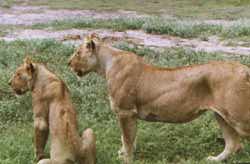 Our trip started in Harare the capital of Zimbabwe and began with
an unexpected surprise that Dutch visitors, since 1-12-98, have to pay USD 30,00
for a visa. Harare is a modern uninspiring city and the next day we
traveled via Kweko and Gweru to Masvingo, the very nice
situated Great Zimbabwe lodge close to the Great Zimbabwe National Monument.
In the 11th century came the first society to occupy the great Zimbabwe site.
The construction of their first project, the royal enclosure on the hill complex
commenced sometime during the 13th century. Despite the beauty of the ruins, the
remains do not provide evidence of superior architectural skills and it seems
that only a sketchy overall plan was devised before work began. At its height,
Great Zimbabwe was a thriving city of at least 10,000 inhabitants. You don't
expect such big stone city in the dark of Africa.
Our trip started in Harare the capital of Zimbabwe and began with
an unexpected surprise that Dutch visitors, since 1-12-98, have to pay USD 30,00
for a visa. Harare is a modern uninspiring city and the next day we
traveled via Kweko and Gweru to Masvingo, the very nice
situated Great Zimbabwe lodge close to the Great Zimbabwe National Monument.
In the 11th century came the first society to occupy the great Zimbabwe site.
The construction of their first project, the royal enclosure on the hill complex
commenced sometime during the 13th century. Despite the beauty of the ruins, the
remains do not provide evidence of superior architectural skills and it seems
that only a sketchy overall plan was devised before work began. At its height,
Great Zimbabwe was a thriving city of at least 10,000 inhabitants. You don't
expect such big stone city in the dark of Africa.
The 305-metre-wide Mutirikwe dam wall blocks the impressive Mutirikwe
Gorge, forming lake Mutirikwe as part of a scheme to irrigate the
parched low field and allow cultivation as cotton and sugar cane. A trip over
the lake to observe the surrounding scenic area is worthwhile and combines
nicely with the visit to Great Zimbabwe.
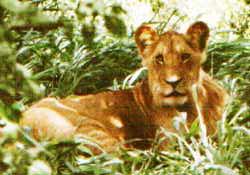 The way from Masvingo to Bulawayo is nice but from Bulawayo
to Hwange is a long monotonous trip over the highlands, with very tame
scenery. Many kilometers with nothing more then lined Eucalyptus or Fir trees
without any interruption is really dull. These fast growing trees are
economically a success but contaminate the landscape. Our destination is the
Hwange Safari Lodge set on the main road into Hwange National Park. The
patio overlooks the hotel's private pan where assorted locals lumbering up for a
drink. Kudu, Elands, Impala's, Waterbucks, Giraffes and Zebras are common, and
Elephants and Buffaloes visit occasionally, we had luck to see an Elephant. Very
early in the morning we have made a game drive through this beautiful park, but
because the grasses stands very high we saw not so much animals. January is the
African summer and raining time, and not the best time for successful game
drive.
The way from Masvingo to Bulawayo is nice but from Bulawayo
to Hwange is a long monotonous trip over the highlands, with very tame
scenery. Many kilometers with nothing more then lined Eucalyptus or Fir trees
without any interruption is really dull. These fast growing trees are
economically a success but contaminate the landscape. Our destination is the
Hwange Safari Lodge set on the main road into Hwange National Park. The
patio overlooks the hotel's private pan where assorted locals lumbering up for a
drink. Kudu, Elands, Impala's, Waterbucks, Giraffes and Zebras are common, and
Elephants and Buffaloes visit occasionally, we had luck to see an Elephant. Very
early in the morning we have made a game drive through this beautiful park, but
because the grasses stands very high we saw not so much animals. January is the
African summer and raining time, and not the best time for successful game
drive.
surf to -www.mediazw.com- for
more information.
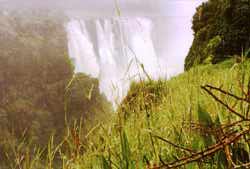
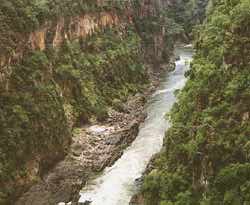 From Hwange we travelled to Victoria Falls were we stayed in
Elephant Hills Hotel. The world-famous Victoria Falls, 1708 meters wide, drops
between 90 and 107 meters into the Zambezi Gorge. An average of 550,000
cubic meters of water plummet over the edge every minute, but during the flood
stage, up to five million cubic meters per minute pas over the falls. This is
what film manufactures had in mind when they dreaming big, many many kilometers
of film and videotape are gobbled through cameras every year here. Although it's
a long way from the kitsch curio shops, traditional dance shows, reptile parks,
adrenaline sports, buzzing and low-flying aircraft and zebra-striped tour buses
all nurture the carnivalesque tourist jungle that has sprouted and taken root in
the city. Fortunately, the star attraction - Victoria Falls itself - is
safely cordoned off by a real jungle of its own creation. To walk along the
paths through the spray-generated rainforest that flank the gorge, you'd never
suspect the existence of anything other than the monumental waterfall that's
giving you a good soaking. Its really an experience to see, feel and hear the
thundering water surrounded by a tropical jungle full of birds, mosquitos and
monkeys , Mosi oa Tunya smoke that thunders called by the Makalolo people.
One of the most dramatic is Cataract View, the westernmost point, which
requires climbing a steep stairway. Another track is aptly named Danger Point,
where terraces of soaking and slippery moss-covered rocks and a sheer and
unfenced 100-metre drop-off conspire to rattle your nerve as you approach the
stunning and frightening view into the First Zambezi Gorge. From Danger Point
you can follow a side track for a view over the gracefully precarious Zambezi
Bridge which connects Zimbabwe with Zambia. Before setting off
for the falls, spend a minute thinking about water and the effects it will have
on your camera equipment and other valuables. You can get a one day permit for a
walk over the old Zambezi bridge (1905) and see 100 meters below in the Botako
Gorge the roaring Zambezi river with some little people in rafts working
very hard to remain inside. On the bridge hundreds locals with goods are waiting
for transport and if you are lucky a train with a very old steaming locomotive.
From Hwange we travelled to Victoria Falls were we stayed in
Elephant Hills Hotel. The world-famous Victoria Falls, 1708 meters wide, drops
between 90 and 107 meters into the Zambezi Gorge. An average of 550,000
cubic meters of water plummet over the edge every minute, but during the flood
stage, up to five million cubic meters per minute pas over the falls. This is
what film manufactures had in mind when they dreaming big, many many kilometers
of film and videotape are gobbled through cameras every year here. Although it's
a long way from the kitsch curio shops, traditional dance shows, reptile parks,
adrenaline sports, buzzing and low-flying aircraft and zebra-striped tour buses
all nurture the carnivalesque tourist jungle that has sprouted and taken root in
the city. Fortunately, the star attraction - Victoria Falls itself - is
safely cordoned off by a real jungle of its own creation. To walk along the
paths through the spray-generated rainforest that flank the gorge, you'd never
suspect the existence of anything other than the monumental waterfall that's
giving you a good soaking. Its really an experience to see, feel and hear the
thundering water surrounded by a tropical jungle full of birds, mosquitos and
monkeys , Mosi oa Tunya smoke that thunders called by the Makalolo people.
One of the most dramatic is Cataract View, the westernmost point, which
requires climbing a steep stairway. Another track is aptly named Danger Point,
where terraces of soaking and slippery moss-covered rocks and a sheer and
unfenced 100-metre drop-off conspire to rattle your nerve as you approach the
stunning and frightening view into the First Zambezi Gorge. From Danger Point
you can follow a side track for a view over the gracefully precarious Zambezi
Bridge which connects Zimbabwe with Zambia. Before setting off
for the falls, spend a minute thinking about water and the effects it will have
on your camera equipment and other valuables. You can get a one day permit for a
walk over the old Zambezi bridge (1905) and see 100 meters below in the Botako
Gorge the roaring Zambezi river with some little people in rafts working
very hard to remain inside. On the bridge hundreds locals with goods are waiting
for transport and if you are lucky a train with a very old steaming locomotive.
The Spencer Creek Crocodile Ranch is a touristic but nevertheless very
interesting attraction. 5000 crocodiles of all sizes, bred on this ranch, are
waiting for their return into the Zambezi river to eliminate vis-eating animals.
Don't visit this ranch if you have in mind to do some white water rafting
otherwise you will be so afraid that you change your plans.
surf to -www.vfsl.com- fir more
information.
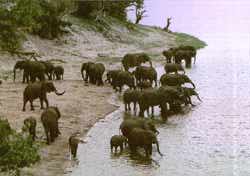 We planned a one day Safari in Botswana. A morning river cruise and an
afternoon 4WD safari in the Chobe National Park which was perfect
organized byodyssey@info.bw. Very
early in the morning they picked us up for a fast and quick drive through Zambesi
Nat. Park to the Botswana border where a 4 WD was waiting to bring us
to a small riverboat. The small boats are preferable to the larger ones because
they accommodate smaller groups and can move in for goods views of the animals
without alarming or endangering them. The Chobe river flowing on the
border of Botswana and Namibia and have a beautiful interesting
riverfront where massive Elephants destroying the bush or take a bath in the
river between couples of Hippo's, Crocodiles which are protecting their babies,
Zebra's and many different antelopes. The variety and abundance of bird life in
this zone of permanent water is remarkable. After a very good lunch we started
with our afternoon game drive in the Chobe game park. As far as wildlife
is concerned, the Chobe Riverfront is the park's most densely inhabited area,
and here, it may seem the word "wildlife" is synonymous with "Elephant".
We saw herds of up to 400 Elephants which is really a exciting view. The
Botswana government bans hunting in the hope that the pressure on the riverfront
vegetation would decrease the elephants, but the population is still booming.
Also Lions, Buffalo's, Giraffes and a great variety of antelopes are walking
around. Except the Rhinoceros we have seen the Big Five during this five hours
afternoon game drive.
We planned a one day Safari in Botswana. A morning river cruise and an
afternoon 4WD safari in the Chobe National Park which was perfect
organized byodyssey@info.bw. Very
early in the morning they picked us up for a fast and quick drive through Zambesi
Nat. Park to the Botswana border where a 4 WD was waiting to bring us
to a small riverboat. The small boats are preferable to the larger ones because
they accommodate smaller groups and can move in for goods views of the animals
without alarming or endangering them. The Chobe river flowing on the
border of Botswana and Namibia and have a beautiful interesting
riverfront where massive Elephants destroying the bush or take a bath in the
river between couples of Hippo's, Crocodiles which are protecting their babies,
Zebra's and many different antelopes. The variety and abundance of bird life in
this zone of permanent water is remarkable. After a very good lunch we started
with our afternoon game drive in the Chobe game park. As far as wildlife
is concerned, the Chobe Riverfront is the park's most densely inhabited area,
and here, it may seem the word "wildlife" is synonymous with "Elephant".
We saw herds of up to 400 Elephants which is really a exciting view. The
Botswana government bans hunting in the hope that the pressure on the riverfront
vegetation would decrease the elephants, but the population is still booming.
Also Lions, Buffalo's, Giraffes and a great variety of antelopes are walking
around. Except the Rhinoceros we have seen the Big Five during this five hours
afternoon game drive.
see www.gov.bw
en
www.interknowledge.com for more information.
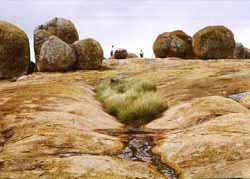 On the way back to Bulawayo we visited in Lupane a kraal (a
fortified family village of round African style huts) with Rondavels by
family Ngwenya to have a small talk and to see how they are living. Only the
oldest daughter is going to school and speaks a little bit English, for the
other children is no money available. A problem is that children needs school
uniforms and that is expensive. Very friendly people which are proud showing you
their livestock, maize, chicken and a goat. Some money or a present is highly
appreciated. In Bulawayo we stayed in Holiday Inn hotel from where we
visited Matobo National Park. Bulawayo (the killing place) was
once head-quarter of the Matabele King Lobengula. You need not be in tune
with any alternative wavelength to sense that the Matobo Hills are one of
the world's playing places of the children from deity's. Thousand-tonne building
blocks, stacking precariously into fanciful castles and towering imaginary
cities, populating with stone-faced human figures. Its no wonder that it is
called a spiritual capital. Close to these balancing stones is a memorial for Rhodes
and Shangani Memorial of the Matabele war from 1893.
On the way back to Bulawayo we visited in Lupane a kraal (a
fortified family village of round African style huts) with Rondavels by
family Ngwenya to have a small talk and to see how they are living. Only the
oldest daughter is going to school and speaks a little bit English, for the
other children is no money available. A problem is that children needs school
uniforms and that is expensive. Very friendly people which are proud showing you
their livestock, maize, chicken and a goat. Some money or a present is highly
appreciated. In Bulawayo we stayed in Holiday Inn hotel from where we
visited Matobo National Park. Bulawayo (the killing place) was
once head-quarter of the Matabele King Lobengula. You need not be in tune
with any alternative wavelength to sense that the Matobo Hills are one of
the world's playing places of the children from deity's. Thousand-tonne building
blocks, stacking precariously into fanciful castles and towering imaginary
cities, populating with stone-faced human figures. Its no wonder that it is
called a spiritual capital. Close to these balancing stones is a memorial for Rhodes
and Shangani Memorial of the Matabele war from 1893.
After some scramble over a steep hill you will reach the Powangwe cave
with wonderful drawings from the bushman. Unfortunately, were the oldest
drawings are (from 35,000 BC), remains only splotchy brown stains and one Kudu
that escaped the stupid mistake to preserve these drawings with shellac. The
remaining drawings are dated around 6500 BC.
To tell the story of rail in Zimbabwe, the Railway Museum houses a collection of
historic steam locomotives, old railway offices and buildings, passenger
carriages and a model of a historic railway station. We didn't visit the Museum
of Natural History because foreigners have to pay USD 10.00 and that is to much.
Close to the Bulawayo Publicity Association is a good and cosy souvenir market (bargaining
is necessary) and a really good coffee shop Two Sisters.
From Bulawayo we traveled via Gwanda to Beitbridge.
Where we leave Zimbabwe for our trip through South Africa. The
scenery in this area is more various and interesting. To cross the border to
South Africa is a chaotic happening and you need a lot of humor and patience. An
exchange-office is unknown, and the whole border looks like a prison with
everywhere electrified barbed wire. If it is not too hot, it is a good idea to
walk the long new Beitbridge into South Africa.
Back to top
 The human history in Zimbabwe extends back through the millennia to the
first rumblings of humanity on earth. Continuing controversy amongst scholars
makes it difficult to determine the latest opinion on who evolved into whom, but
most accept that the earliest human-like creatures were a group op
upright-walking hominids who became established nearly four million years ago in
the savannas of southern and eastern Africa. At least one advanced variety of
these small creatures developed rudimentary tool-making abilities around 1.3
million years ago, allowing people to hunt rather than just scavenge for food.
This, combined with a series of climatic changes, led to an increase of brain
size, changes in body form and a growing population.The next clearly
identifiable stage is an early form of human called Homo Erectus, whose
camps and stones are found scattered throughout the region. One archaeological
site provide evidence that these early people were hunting the ancestors of
present-day elephants and butchering their remains with stone hand-axes as early
as 750,000 years ago. The tools of the era were large and clumsy, but by 150,000
years ago, people were using lighter stone point, projectile heads, knives, and
other finer tools useful for much various hunting and gathering activities. By
the middle Stone Age, which lasted until 20,000 years ago, the Boskopoid
people, the primary human group and presumed ancestry of the present-day San,
or Bushmen, had progressed into an organized hunting and gathering
society. Use of fire was universal, tools - now made from wood and animals
products as well as stone - had become more sophisticated and natural pigments
were being used for personal adornment. Between 20,000 and 30,000 years ago they
made sudden and significant progress in their standard of tool manufacture.
Tools became smaller and better designed and this greatly increased hunting
efficiency and allowed time for further innovation and artistic pursuits. This
stage is known as the microlithic revolution.. When and from where the Khoi-Khoi
(Hottentot) arrived in this region is not clear, but around 10,000 years ago
people began to producing pottery and drawings and occupied rock shelters and
caves all over southern Africa. Specific for the Khoi-Khoi are the
enormous bottoms of their woman (Steatopgygie). The San seem to have come under
pressure from the Khoi-Khoi. The Khoi-Khoi were tribally organized
people who raised stock rather than hunted and who were probably responsible for
the region's first pottery production. During the late Iron Age, between 2300
and 2400 years ago, rudimentary farming techniques appeared on the plateaux
probably from Bantu speaking migrants fleeing the advancing deserts of
northern Africa. Between 500 and 1000 AD, the Gokomere and subsequent
groups developed gold-mining in the region and produced progressively finer
quality ceramics, jewellery and soapstone carvings, Cattle ranching became the
mainstay of the community and the earlier San groups disappeared from the
scene. As early as the 11th century, some foundations and stonework were already
in place at Great Zimbabwe and the settlement, generally regarded as the
nascent Shona society, came into contact with Swahili traders.
They traded African gold and Ivory for glass, porcelain and cloth from Asia; Great
Zimbabwe became the capital of the wealthiest and most powerful society in
Africa. By the 15th century, Great Zimbabwe's influence had crested and begun to
decline. Although reasons for its ultimate desertion remain something of a
mystery. From mid 1500 first the Portuguese, later on the Zulu's and de Boers
from South Africa and finally the British plundered the country.
The human history in Zimbabwe extends back through the millennia to the
first rumblings of humanity on earth. Continuing controversy amongst scholars
makes it difficult to determine the latest opinion on who evolved into whom, but
most accept that the earliest human-like creatures were a group op
upright-walking hominids who became established nearly four million years ago in
the savannas of southern and eastern Africa. At least one advanced variety of
these small creatures developed rudimentary tool-making abilities around 1.3
million years ago, allowing people to hunt rather than just scavenge for food.
This, combined with a series of climatic changes, led to an increase of brain
size, changes in body form and a growing population.The next clearly
identifiable stage is an early form of human called Homo Erectus, whose
camps and stones are found scattered throughout the region. One archaeological
site provide evidence that these early people were hunting the ancestors of
present-day elephants and butchering their remains with stone hand-axes as early
as 750,000 years ago. The tools of the era were large and clumsy, but by 150,000
years ago, people were using lighter stone point, projectile heads, knives, and
other finer tools useful for much various hunting and gathering activities. By
the middle Stone Age, which lasted until 20,000 years ago, the Boskopoid
people, the primary human group and presumed ancestry of the present-day San,
or Bushmen, had progressed into an organized hunting and gathering
society. Use of fire was universal, tools - now made from wood and animals
products as well as stone - had become more sophisticated and natural pigments
were being used for personal adornment. Between 20,000 and 30,000 years ago they
made sudden and significant progress in their standard of tool manufacture.
Tools became smaller and better designed and this greatly increased hunting
efficiency and allowed time for further innovation and artistic pursuits. This
stage is known as the microlithic revolution.. When and from where the Khoi-Khoi
(Hottentot) arrived in this region is not clear, but around 10,000 years ago
people began to producing pottery and drawings and occupied rock shelters and
caves all over southern Africa. Specific for the Khoi-Khoi are the
enormous bottoms of their woman (Steatopgygie). The San seem to have come under
pressure from the Khoi-Khoi. The Khoi-Khoi were tribally organized
people who raised stock rather than hunted and who were probably responsible for
the region's first pottery production. During the late Iron Age, between 2300
and 2400 years ago, rudimentary farming techniques appeared on the plateaux
probably from Bantu speaking migrants fleeing the advancing deserts of
northern Africa. Between 500 and 1000 AD, the Gokomere and subsequent
groups developed gold-mining in the region and produced progressively finer
quality ceramics, jewellery and soapstone carvings, Cattle ranching became the
mainstay of the community and the earlier San groups disappeared from the
scene. As early as the 11th century, some foundations and stonework were already
in place at Great Zimbabwe and the settlement, generally regarded as the
nascent Shona society, came into contact with Swahili traders.
They traded African gold and Ivory for glass, porcelain and cloth from Asia; Great
Zimbabwe became the capital of the wealthiest and most powerful society in
Africa. By the 15th century, Great Zimbabwe's influence had crested and begun to
decline. Although reasons for its ultimate desertion remain something of a
mystery. From mid 1500 first the Portuguese, later on the Zulu's and de Boers
from South Africa and finally the British plundered the country.
 Our trip started in Harare the capital of Zimbabwe and began with
an unexpected surprise that Dutch visitors, since 1-12-98, have to pay USD 30,00
for a visa. Harare is a modern uninspiring city and the next day we
traveled via Kweko and Gweru to Masvingo, the very nice
situated Great Zimbabwe lodge close to the Great Zimbabwe National Monument.
In the 11th century came the first society to occupy the great Zimbabwe site.
The construction of their first project, the royal enclosure on the hill complex
commenced sometime during the 13th century. Despite the beauty of the ruins, the
remains do not provide evidence of superior architectural skills and it seems
that only a sketchy overall plan was devised before work began. At its height,
Great Zimbabwe was a thriving city of at least 10,000 inhabitants. You don't
expect such big stone city in the dark of Africa.
Our trip started in Harare the capital of Zimbabwe and began with
an unexpected surprise that Dutch visitors, since 1-12-98, have to pay USD 30,00
for a visa. Harare is a modern uninspiring city and the next day we
traveled via Kweko and Gweru to Masvingo, the very nice
situated Great Zimbabwe lodge close to the Great Zimbabwe National Monument.
In the 11th century came the first society to occupy the great Zimbabwe site.
The construction of their first project, the royal enclosure on the hill complex
commenced sometime during the 13th century. Despite the beauty of the ruins, the
remains do not provide evidence of superior architectural skills and it seems
that only a sketchy overall plan was devised before work began. At its height,
Great Zimbabwe was a thriving city of at least 10,000 inhabitants. You don't
expect such big stone city in the dark of Africa. The way from Masvingo to Bulawayo is nice but from Bulawayo
to Hwange is a long monotonous trip over the highlands, with very tame
scenery. Many kilometers with nothing more then lined Eucalyptus or Fir trees
without any interruption is really dull. These fast growing trees are
economically a success but contaminate the landscape. Our destination is the
Hwange Safari Lodge set on the main road into Hwange National Park. The
patio overlooks the hotel's private pan where assorted locals lumbering up for a
drink. Kudu, Elands, Impala's, Waterbucks, Giraffes and Zebras are common, and
Elephants and Buffaloes visit occasionally, we had luck to see an Elephant. Very
early in the morning we have made a game drive through this beautiful park, but
because the grasses stands very high we saw not so much animals. January is the
African summer and raining time, and not the best time for successful game
drive.
The way from Masvingo to Bulawayo is nice but from Bulawayo
to Hwange is a long monotonous trip over the highlands, with very tame
scenery. Many kilometers with nothing more then lined Eucalyptus or Fir trees
without any interruption is really dull. These fast growing trees are
economically a success but contaminate the landscape. Our destination is the
Hwange Safari Lodge set on the main road into Hwange National Park. The
patio overlooks the hotel's private pan where assorted locals lumbering up for a
drink. Kudu, Elands, Impala's, Waterbucks, Giraffes and Zebras are common, and
Elephants and Buffaloes visit occasionally, we had luck to see an Elephant. Very
early in the morning we have made a game drive through this beautiful park, but
because the grasses stands very high we saw not so much animals. January is the
African summer and raining time, and not the best time for successful game
drive.
 From Hwange we travelled to Victoria Falls were we stayed in
Elephant Hills Hotel. The world-famous Victoria Falls, 1708 meters wide, drops
between 90 and 107 meters into the Zambezi Gorge. An average of 550,000
cubic meters of water plummet over the edge every minute, but during the flood
stage, up to five million cubic meters per minute pas over the falls. This is
what film manufactures had in mind when they dreaming big, many many kilometers
of film and videotape are gobbled through cameras every year here. Although it's
a long way from the kitsch curio shops, traditional dance shows, reptile parks,
adrenaline sports, buzzing and low-flying aircraft and zebra-striped tour buses
all nurture the carnivalesque tourist jungle that has sprouted and taken root in
the city. Fortunately, the star attraction - Victoria Falls itself - is
safely cordoned off by a real jungle of its own creation. To walk along the
paths through the spray-generated rainforest that flank the gorge, you'd never
suspect the existence of anything other than the monumental waterfall that's
giving you a good soaking. Its really an experience to see, feel and hear the
thundering water surrounded by a tropical jungle full of birds, mosquitos and
monkeys , Mosi oa Tunya smoke that thunders called by the Makalolo people.
One of the most dramatic is Cataract View, the westernmost point, which
requires climbing a steep stairway. Another track is aptly named Danger Point,
where terraces of soaking and slippery moss-covered rocks and a sheer and
unfenced 100-metre drop-off conspire to rattle your nerve as you approach the
stunning and frightening view into the First Zambezi Gorge. From Danger Point
you can follow a side track for a view over the gracefully precarious Zambezi
Bridge which connects Zimbabwe with Zambia. Before setting off
for the falls, spend a minute thinking about water and the effects it will have
on your camera equipment and other valuables. You can get a one day permit for a
walk over the old Zambezi bridge (1905) and see 100 meters below in the Botako
Gorge the roaring Zambezi river with some little people in rafts working
very hard to remain inside. On the bridge hundreds locals with goods are waiting
for transport and if you are lucky a train with a very old steaming locomotive.
From Hwange we travelled to Victoria Falls were we stayed in
Elephant Hills Hotel. The world-famous Victoria Falls, 1708 meters wide, drops
between 90 and 107 meters into the Zambezi Gorge. An average of 550,000
cubic meters of water plummet over the edge every minute, but during the flood
stage, up to five million cubic meters per minute pas over the falls. This is
what film manufactures had in mind when they dreaming big, many many kilometers
of film and videotape are gobbled through cameras every year here. Although it's
a long way from the kitsch curio shops, traditional dance shows, reptile parks,
adrenaline sports, buzzing and low-flying aircraft and zebra-striped tour buses
all nurture the carnivalesque tourist jungle that has sprouted and taken root in
the city. Fortunately, the star attraction - Victoria Falls itself - is
safely cordoned off by a real jungle of its own creation. To walk along the
paths through the spray-generated rainforest that flank the gorge, you'd never
suspect the existence of anything other than the monumental waterfall that's
giving you a good soaking. Its really an experience to see, feel and hear the
thundering water surrounded by a tropical jungle full of birds, mosquitos and
monkeys , Mosi oa Tunya smoke that thunders called by the Makalolo people.
One of the most dramatic is Cataract View, the westernmost point, which
requires climbing a steep stairway. Another track is aptly named Danger Point,
where terraces of soaking and slippery moss-covered rocks and a sheer and
unfenced 100-metre drop-off conspire to rattle your nerve as you approach the
stunning and frightening view into the First Zambezi Gorge. From Danger Point
you can follow a side track for a view over the gracefully precarious Zambezi
Bridge which connects Zimbabwe with Zambia. Before setting off
for the falls, spend a minute thinking about water and the effects it will have
on your camera equipment and other valuables. You can get a one day permit for a
walk over the old Zambezi bridge (1905) and see 100 meters below in the Botako
Gorge the roaring Zambezi river with some little people in rafts working
very hard to remain inside. On the bridge hundreds locals with goods are waiting
for transport and if you are lucky a train with a very old steaming locomotive. We planned a one day Safari in Botswana. A morning river cruise and an
afternoon 4WD safari in the Chobe National Park which was perfect
organized by
We planned a one day Safari in Botswana. A morning river cruise and an
afternoon 4WD safari in the Chobe National Park which was perfect
organized by On the way back to Bulawayo we visited in Lupane a kraal (a
fortified family village of round African style huts) with Rondavels by
family Ngwenya to have a small talk and to see how they are living. Only the
oldest daughter is going to school and speaks a little bit English, for the
other children is no money available. A problem is that children needs school
uniforms and that is expensive. Very friendly people which are proud showing you
their livestock, maize, chicken and a goat. Some money or a present is highly
appreciated. In Bulawayo we stayed in Holiday Inn hotel from where we
visited Matobo National Park. Bulawayo (the killing place) was
once head-quarter of the Matabele King Lobengula. You need not be in tune
with any alternative wavelength to sense that the Matobo Hills are one of
the world's playing places of the children from deity's. Thousand-tonne building
blocks, stacking precariously into fanciful castles and towering imaginary
cities, populating with stone-faced human figures. Its no wonder that it is
called a spiritual capital. Close to these balancing stones is a memorial for Rhodes
and Shangani Memorial of the Matabele war from 1893.
On the way back to Bulawayo we visited in Lupane a kraal (a
fortified family village of round African style huts) with Rondavels by
family Ngwenya to have a small talk and to see how they are living. Only the
oldest daughter is going to school and speaks a little bit English, for the
other children is no money available. A problem is that children needs school
uniforms and that is expensive. Very friendly people which are proud showing you
their livestock, maize, chicken and a goat. Some money or a present is highly
appreciated. In Bulawayo we stayed in Holiday Inn hotel from where we
visited Matobo National Park. Bulawayo (the killing place) was
once head-quarter of the Matabele King Lobengula. You need not be in tune
with any alternative wavelength to sense that the Matobo Hills are one of
the world's playing places of the children from deity's. Thousand-tonne building
blocks, stacking precariously into fanciful castles and towering imaginary
cities, populating with stone-faced human figures. Its no wonder that it is
called a spiritual capital. Close to these balancing stones is a memorial for Rhodes
and Shangani Memorial of the Matabele war from 1893.